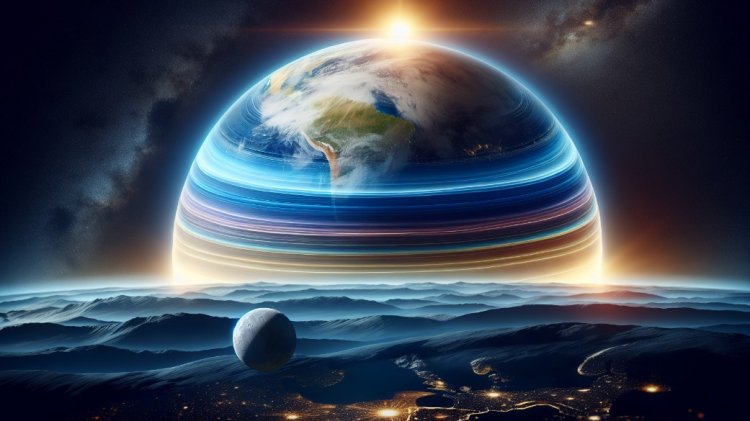No Human Has Ever Left Earth’s Atmosphere, Here's Why
Earth's atmosphere stretches far beyond textbooks! Discover the shocking truth about its vastness and why, technically, no human has ever left it. Brace for a cosmic perspective shift!

Introduction
Scientists have argued about where space starts and the Earth's atmosphere ends during the history of space exploration. New observations show that our atmosphere is bigger than we thought. Actually, it goes farther than the moon!
Defining Space
In the past, people have described space as the huge area of the universe that is above the Kármán Line. This line is about 100 kilometers above the level of the sea. The Federation Aeronautique Internationale (FAI), the organization responsible for making these rules, agrees with this designation. The FAI says that when you cross the Kármán Line, you are officially in space. The reason for this is that the Earth's atmosphere becomes too thin for regular planes to stay in the air without going really fast. We need special vehicles for space travel from here.
But there is no agreed-upon global agreement on the exact point where space officially starts. Some scientists who study space think that satellites should be positioned 80 kilometers above the surface of the ocean. They believe this because of how orbital momentum affects objects in space. NASA and the U.S. Air Force say that space begins at around 80 kilometers above the Earth. Once someone crosses this point, they are considered an astronaut.
The Layers of the Atmosphere
The atmosphere is like a bubble of gases that surround and protect the Earth. It has different layers and is a complicated system.
-
The troposphere is where weather happens and where we find important gases for breathing and staying alive.
-
Commercial airlines like the stratosphere because it has less turbulence.
-
The mesosphere is a layer in the Earth's atmosphere where meteors burn up and clouds can form.
-
The thermosphere is where the Kármán Line is located. This is where astronauts feel like they have no weight, and this is where the International Space Station (ISS) goes around.
-
The exosphere is the outer layer that keeps us separate from outer space. It is made up of very few hydrogen and helium atoms that slowly disappear into empty space.
Before, scientists did not know the exact line that separates the exosphere from outer space. People thought that the exosphere went away about 200,000 kilometers from Earth. But new observations of the geocorona, a glow made when the outermost layer of Earth's atmosphere reflects the sun's UV light, show that this layer may reach as far as 630,000 kilometers. This distance includes the moon, which means that the moon is technically considered to be part of Earth's atmosphere!
Discovering the Geocorona
The Solar Wind Anisotropies Instrument (SWAN) is responsible for these amazing discoveries. SWAN was created to study and understand the geocorona, which helps us learn more about our atmosphere. When sunlight meets hydrogen atoms in the exosphere, it creates Lyman-alpha radiation. Astrophysicists use this radiation to study structures in deep space. But the layers inside our atmosphere soak up Lyman-alpha radiation, so we can't see it from Earth. SWAN, from its spot in space, could see and measure Lyman-alpha radiation and the geocorona. This helped show that the geocorona is much bigger than previously thought.
Implications for Space Travel
While this discovery is very important, it will not have a big effect on practical space travel. But it will help us learn a lot about space in the future. The new discoveries also show that sunlight squishes the hydrogen atoms in the outer layer of the Earth's atmosphere, making some areas more crowded with geocorona and giving off Lyman-alpha radiation. Telescopes in space that are in the exosphere have to think about this when looking at the sky at night. These telescopes can help us see farther into space more accurately by considering the Lyman-alpha baseline level and the clustering of the geocorona.
Archived Discoveries
It is interesting to know that SWAN made these observations in the late 1990s, but they were only recently found again in the archives for further study. This makes us wonder what other unexpected findings might be waiting to be discovered. What other things might be hidden in a cupboard?
FAQ
Where does space officially begin?
There is no official international consensus on where space technically begins. Different organizations and scientists have proposed various thresholds, such as the Kármán Line at roughly 100 kilometers above sea level.
How far does the Earth's atmosphere extend?
Recent observations suggest that the Earth's atmosphere, specifically the exosphere, may extend up to 630,000 kilometers away from the surface. This distance includes the moon.
What is the geocorona?
The geocorona is a glow created when the exosphere reflects the sun's UV light. It provides valuable insights into the extent of our atmosphere.
What is Lyman-alpha radiation?
The inner layers of our atmosphere absorb a wavelength of light known as Lyman-alpha radiation. Astrophysicists use it to investigate cosmological structures in deep space.
How will these discoveries impact space travel?
While these discoveries won't have a significant impact on practical space travel, they will greatly enhance our understanding of space and inform future observations.



 admin
admin 










